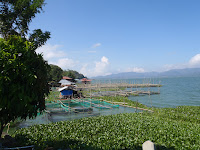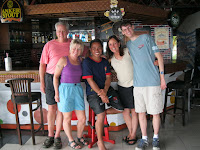After leaving Tangkoko Reserve we passed by a small coconut processing operation where we learned about how many uses there were for coconut trees. The wood from the trunk is used for furniture, the roots are used as coals for kilns, the husk is used for fire wood, woven mats, and filling for upholstery and then of course there is the meat, juice and oil all used for consumption. What a useful tree.
Moving on, we entered a small town where we saw many homes with cloves drying on tarps outside on the patios. We were also taken to a cemetery where the government had moved many ancient tombstones.
Leaving the town behind, we made our way up through the Minihasa highlands. We stopped by a couple of caves that were used by the Japanese during WW11. Inside the caves were several tunnels. Shining my light into one of the tunnels I noticed several pairs of beady red eyes staring back at me from the ceiling and walls. Upon closer inspection we discovered they belonged to huge rather ghastly looking spiders. Our guide assured us that they weren’t poisonous – still we all jumped when one of them scampered toward us while taking its picture. Another one of the caves inhabitants was swallows. These were the swallows whose nests they use for birds nest soup. There were several nests along the ceiling with baby birds in them.
From the caves we continued up through a stunning array of agricultural settings. There were immaculately terraced gardens that sported a wide variety of vegetables. Spice trees (clove, vanilla, nutmeg, and cinnamon) were growing right beside the road.
Our next stop was a traditional Minihasan market. This was the first of our sights that revealed some startling cultural differences. There was a lovely display of many fruits and vegetables, but when we came to the meat section there were fruit bats and dogs. Our guide confirmed that many of the people eat bats, rats and dogs on special occasions. Sometimes they even eat their own dog, but often they will go to a neighbor or another village and request to purchase someone’s dog. He said sometimes they also eat cats, but that the cats are less often consumed as they are considered useful in controlling the rat population. Hmmmm….. Ok moving on to a happier topic.
As luck would have it (with us all feeling slightly nauseous), our next stop was lunch. We stopped at restaurant on the banks of a large lake. Luckily, we had no unidentifiable meat on the menu. All around the lake were homes with fish farms and oddly there was almost nobody out on the lake.
We had 2 more stops to try and squeeze in as our incredibly full day was coming to an end. We breezed by Lake Linow known as the color changing lake. It is a volcanic lake that changes color from red to yellow, green, and blue. It is surrounded by exotic looking pine trees and has beautifully manicured grounds – perfect for a picnic.
Our final stop was to see prefab traditional Indonesian-style homes. They can be purchased for $5000.00 - $20,000.00 depending on the size and shipped anywhere in the world. They are made primarily from a local wood called Iron Wood.
Whew!!!! It was a lot of things to see in one day, but what an incredible experience.
Tuesday, September 28, 2010
Tangkoko Nature Reserve North Sulawesi
After a fabulous week of diving at Tasik Ria, we left the splendor of the Celebes Sea and headed for the hills – the Minihasa Highlands to be exact. First we traversed the island to Tangkoko Nature Reserve where we hoped to view Tarsiers (one of the smallest primates in the world), Black Macaque Monkeys, Great Hornbills, and Fruit Bats.
We started our tour at 4:45 P.M. after checking in at Mama Roos Homestay (a basic accommodation located just outside of the reserve). We headed off on a dirt road, but quickly moved off into the brush at the side of the road. We were forewarned about the abundance of biting midges or chiggers, so were we well armed with DEET. Along the way our guide handed me a piece of fruit he picked from a tree. It turned out to be wild guava. It was delicious!
Eventually we arrived at a large Fichus tree, where we were told to wait with flash lights, and cameras standing by for the star attraction of the night – the Tarsiers. It wasn’t long before the first little guy poked his head out. At that moment everyone fell instantly in love. Its huge bug eyes, little turned up nose, expressive (Yoda-like) ears, and perpetual smile elicited a collective awwhh!!!! One after another the rest of them appeared and went on about their business seemingly unaffected by our presence. Our guide informed us that they can jump up to 3 meters and perform 360’s while jumping from tree to tree.
We started our tour at 4:45 P.M. after checking in at Mama Roos Homestay (a basic accommodation located just outside of the reserve). We headed off on a dirt road, but quickly moved off into the brush at the side of the road. We were forewarned about the abundance of biting midges or chiggers, so were we well armed with DEET. Along the way our guide handed me a piece of fruit he picked from a tree. It turned out to be wild guava. It was delicious!
Eventually we arrived at a large Fichus tree, where we were told to wait with flash lights, and cameras standing by for the star attraction of the night – the Tarsiers. It wasn’t long before the first little guy poked his head out. At that moment everyone fell instantly in love. Its huge bug eyes, little turned up nose, expressive (Yoda-like) ears, and perpetual smile elicited a collective awwhh!!!! One after another the rest of them appeared and went on about their business seemingly unaffected by our presence. Our guide informed us that they can jump up to 3 meters and perform 360’s while jumping from tree to tree.
On our way back from the Tarsier encounter we passed by a brown tree snake and 2 Tarantulas.
The next morning we were up at 4:30 A.M. to see the Black Macaque Monkeys, Great Hornbills, and Fruit Bats. We got skunked on the Fruit Bat sighting and had only a fleeting view of a Great Hornbill as it took off - never to return. We were taunted periodically throughout our hike with the sound of its massive wing beat. The heavy whoosh, whoosh, whoosh sounds like it might belong to something the size of a Pterodactyl.
We located a large troop of Black Macaques chattering up in the canopy. We waited patiently and after
about 15 minutes they all descended upon us to begin their morning foraging. Like the Tarsier, they too seemed unaffected by our presence and approached within a couple of feet.
We spent about 5 hours traipsing around the reserve, stopped briefly by Mama Roos for a quick bite and a shower, then piled into our Zebra-stripped van and sped off to our next series of adventures.
Monday, September 13, 2010
North Sulawesi Adventure
We have just completed our first week of adventure in Sulawesi at Tasik Ria Resort. We had a fabulous 6 days of diving. Bunaken National Park is a nice mixture of wall dives, sloping reefs, and muck diving. There are a large number and variety of fish here including: monster Napolean wrasse, and massive schools of Butterfly Fish - a cascade of brilliant yellow pouring over sheer walls into an indigo abyss. Every day we encountered a multitude of new and amazing critters like: the Pegasus Sea Moth (looks like a Sea horse with wings), the Crocodile snake eel, and the most exotic Sea Cucumber I’ve ever seen – I dubbed it the Warrior Sea Cucumber.
The staff at Tasik Ria are all warm and friendly and are quick to attend to any needs or requests. The resort is in a lovely tropical garden setting and the sunsets from the jetty bar are breathtaking. The weather has been a mixture of sun and some tropical afternoon and evening showers. The day before we left, we got to experience a real toad choker of a tropical downpour. That day we got to wade through ankle deep puddles around the resort.
Today we head out to Tangkoko Nature Preserve to see Macaque Monkeys, and the Tarsier Monkey (words smallest primate). This will be a night hike in the jungle, as that’s when the little guys come out to feed. From there we move on to the Minihasa Highlands to see some local culture, markets, and mountain lakes. Stay tuned for the next blog highlights that will include reviews and photos of Tangkoko and Minihasa.
Subscribe to:
Posts (Atom)











































